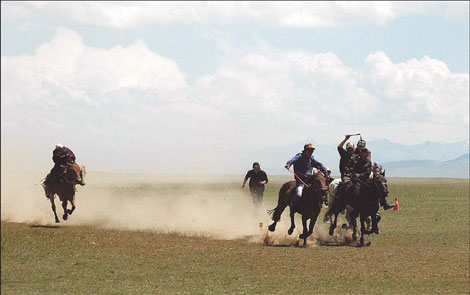Playing horse whisperer
 |
| Local herdsmen showcase the prowess of their horses on the Bayanbulak grasslands in Xinjiang. |
Equestrian endurance racing is a sport that tests the mental and physical limits of both rider and horse. Alexis Hooi gets a taste of this deep in the heart of Xinjiang.
Packs of horses break through the morning mist on the horizon, as local grooms nearby slap on saddles and tighten bridles on their prized geldings and mares. The rising sun lights up the deep-blue sky above and slowly dissipates the dew on the surrounding yurts, decorated with ethnic Mongolian tapestry. I am in Bayanbulak, one of the country's largest and most beautiful grasslands in the Beyinguoleng Mongolian autonomous prefecture of the Xinjiang Uygur autonomous region. But my heart pounds louder than the horses running about me and enjoying the breathtaking scenery is the last thing on my mind.
Instead, I am focused on making it through the 2nd Bayanbulak Swan Lake Equestrian Endurance Race being held in Xinjiang's Hejing county.
When the local authorities organized the area's first equestrian endurance race last year, at least six horses out of the more than 100 that took part dropped dead from exhaustion.
Riders had to cover more than 150 km in less than a day on local Mongolian horses famous for their strength and stamina.
But this year, competition organizers promise a different approach: The race goes global and has to adhere to international competition standards as set out by the International Federation for Equestrian Sports or FEI, the worldwide governing body for the sport.
This means the welfare of the horses in the race will be given top priority.
Ho Nai Yue, president of the Asian Equestrian Federation, commends the move.
"This will raise the profile of the sport in the country," Ho tells China Daily in a telephone interview.
More than 100 competitors from home and abroad take part in the Bayanbulak race this year. In line with FEI standards, they have to cover 80 km on their horses in four stages in the daylong race. A total prize money of 556,000 yuan ($82,000) is up for grabs, with trophies in various categories ranging from "best individual time" and "best team" to "best female rider" and "best condition horse".
I enter the race representing my country, Singapore. But for an amateur rider such as myself, the competition is even more challenging because my horse is assigned to me by lot. There is little time for us to accustom ourselves to each other, a crucial factor in an activity that requires full understanding between a rider and his horse.
As whips and spurs are also prohibited to prevent the horses from being abused, I have to rely even more on the basics of riding to control my mount.
FEI standards also demand compulsory rest and watering points as well as veterinary checks for the horses between the competition stages. Vets can stop lame or injured horses from continuing the race. To ensure that the animals are adequately rested and not driven to exhaustion, competitors who lead horses into the vet checkpoints with pulse rates higher than 64 beats a minute are disqualified.
Few activities can match the adrenalin rush that comes from being atop a horse at the starting gates of an equestrian race. Competitors begin to jostle for good positions at the front even before the flag-off.
 0
0 







Go to Forum >>0 Comments